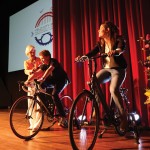. As the second-largest-attended education meeting in the United States — attracting more than 9,400 attendees this past year — the Capital Conference brings together educators, school board members, and administrators to learn about the latest advancements in public education. It also makes a place for Ohio’s more than 1.6 million students, who are able to showcase their work at a one-of-a-kind Student Achievement Fair.
Challenges
Facing tough spending cuts, public school districts need to be cautious when it comes to professional development. (Read our Pre Con profile of the Capital Conference.) OSBA avoids this problem by providing a school district the opportunity to pay registration for its first six educators, allowing anyone else from the district to attend for free. “We had 46 percent of our members using that [program],” said Jeff Chambers, OSBA’s director of communication services. “Districts will send coordinators just to talk to vendors in our trade show, knowing they’re just paying for mileage and lunch.”
Convenience was key at the 2012 conference, especially with the brand-new Hilton Columbus Downtown having opened the month before. Directly connected to the convention center, the hotel provided easy access for attendees, keeping them close and providing more networking opportunities. “The skywalk between the hotel and convention center opened the day of our conference,” Chambers said. “It was certainly more of a benefit for us to have more people downtown, in terms of keeping people in close proximity to the convention center.”
OSBA also took advantage of a new addition to the convention center, using it for luncheons and evening receptions. “It was easier for our attendees to move from one location to another,” Chambers said. “It was a larger space, and we were able to have more seating, more tables and chairs. There was a lot more people taking advantage [of their time] and staying a little longer.”
Chambers had anticipated potential problems at the 2012 conference due to changes in loading-dock security at the convention center. “They changed the process,” Chambers said, “following more restrictions from Homeland Security. They tightened [the rules about] who could get into the loading dock and who couldn’t — our exhibitors were used to just going in and parking and having their vehicle on the dock [for hours], but they had specific time limits.” Despite the change in procedure, “everything worked well,” Chambers said, giving credit to the convention center staff. “They were keeping on top of everything and keeping everyone moving.”
Initiatives
One of the most important efforts at the 2012 Capital Conference was to educate school districts on new changes to Ohio’s Common Core State Standards — in the process reinforcing an old elementary-school lesson: Sharing is caring. “We had a variety of different subjects on Common Core,” Chambers said. “A number of sessions were on districts sharing services, which is something that we’re trying to promote, and the state is trying to promote — sharing transportation or a superintendent. We discussed how they can save some money while still maintaining high quality.”
OSBA also streamlined the learning process for attendees by providing a conference app for the third year in a row. “More of our attendees are using the app,” Chambers said. “Staff are now using the app to help people find sessions and answer questions. Technology continues to be a strong part of the conference.”
OSBA also saw more participation at its Student Achievement Fair, home to 100 booths showcasing the talents of various Ohio school districts. “The Student Achievement Fair went very well,” Chambers said. “There is always more and more people trying to get in there — it seems to grow every year.”
OSBA Capital Conference Details
2011 Columbus
- 9,819 Attendees
- 629
Exhibitors
2012 Columbus
- 9,422 Attendees
- 603 Exhibitors
For more information, visit Ohio School Board’s 2012 Capital Conference.
Convene’s Pre-Con/Post-Con series asks meeting planners about their challenges and how they intend to address them (Pre-Con), and then circles back around after the meeting has occurred (Post-Con) to see how well they worked out.



